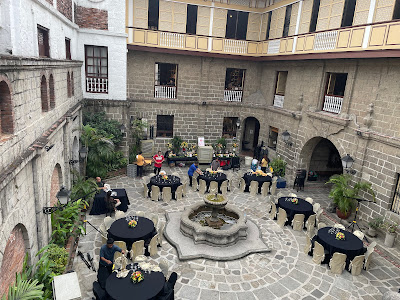Manila - We took a grab from our hotel to St Augustin Church. A beautiful church but there was a wedding and was not allowed to enter the church surrounded by numerous friends and relatives of the wedding couple dressed in fancy dresses.
 |
| St Augustin Church |
 |
| fancy Starbucks |
 |
| Beautiful cobblestones road |
Time flies, the last time I was walking around Intramuros was 2013 (10 years ago). The last time, we took a Calesa - a horse driven cart but now it was an electric scooter and a young boy (16 years old) at the driver seat. This young boy was an enthusiastic tour guide too, explaining the places along the way. From Php 350 it came down to Php 200 for both of us - we kept saying not interested and price kept dropping.
Pintong Real
Pintong Real (Royal Gate) this is one of the historical markers around the Intramuros city. This was a prison used by the Spanish to incarcerate people.
 |
| Pintong Real entrance |
Baluarte San Andres
This was part of the Spanish colonial fortification in the historic Walled City. It was built in 1603 to protect the Puerto Real and the southeastern part of Intramuros.
 |
| Intramuros wall |
 |
| Looking across from the wall |
Baluarte de San Diego
This circular tower was meant to defend Manila’s southern bayside boundary. In 1593, the upper portion of the tower was demolished after suffering from cracks. The rest of the structure was integrated into a new bulwark called Baluarte de San Diego. Completed sometime between 1653 and 1663, Baluarte de San Diego is shaped like an ace of spades. It was breached by the British forces with cannon fire in 1762, and was restored when the Spaniards returned. The earthquake of 1863 destroyed the structure, leading to its abandonment. During the American occupation, the circular fort was buried under layers of soil which eventually saved it from destruction during the Battle of Manila in 1945 despite the damage sustained by the baluarte containing it.
 |
Baluarte de San Diego
|
This used to be an old watchtower.
 |
| Donny on the other side |
 |
| Canon pit overlooking the Golf course |
Casa Manila
The Casa Manila or “Manila House” is a living museum that features the lifestyle of an affluent Filipino family during the late Spanish colonial period. The façade of Casa Manila was patterned after a house that once stood at Jaboneros Street in the Chinese district of Binondo in the 1850's.




















No comments:
Post a Comment